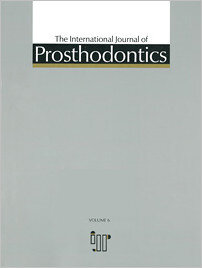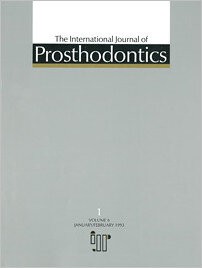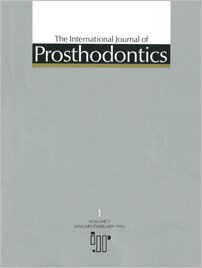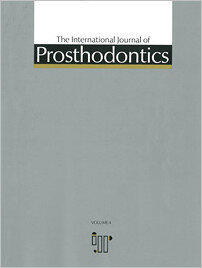Pages 331, Language: EnglishPreston, Jack D.Pages 333-340, Language: EnglishJackson / Lang / WangThe Michigan Computer Graphics Coordinate Measuring System was used to determine the influence of denture teeth on the accuracy of processed denture bases. Three different processing methods - compression molding, injection pressing, and vacuum-assisted resin pouring - were used. The presence of denture teeth was determined to affect the accuracy of the processed denture bases of all three techniques. For denture bases without teeth, the compression-molding technique demonstrated significant differences in accuracy; however, no significant differences were found in the injection-pressed or resin-poured denture bases.
Pages 341-345, Language: EnglishKotkin / Slabbert / Becker / CarrThis study tested whether information obtained from an inventory of denture-related variables can help a dentist recognise the potentially slowly adapting denture patient. Sixty-one patients completed an inventory of denture complaints prior to the fabrication of complete maxillary and mandibular dentures. Subjects were subsequently divided into groups of slowly adapting and rapidly adapting patients. A clinically derived classification was compared to a theoretic model. Seventy-four percent of the theoretically slowly adapting patients and 89% of the theoretically rapidly adapting patients corresponded with their clinical classifications.
Pages 346-363, Language: EnglishTan / Rubenstein / Nicholls / YuodelisThe three-dimensional distortions of implant frameworks of two designs, reflecting the early Toronto U-shaped design and a current L-shaped design, were measured. A conventional commercial laboratory one-piece casting method, using a silver-palladium alloy, was used. Distortion was defined by five displacement variables for the centroids of each of five gold cylinders incorporated in each casting: three orthogonal translational displacements (dx, dy, and dz) and two rotational displacements (d theta x and d theta y). A computerized coordinate measuring machine was used. Overall translational displacements measured were -17.4 ± 15 microns for dx, 6.1 ± 7.1 microns for dy, and -0.1 ± 1.7 microns for dz. The overall global translational displacement, dR, was 20.2 ± 14.5 microns. Overall rotational displacements were -0.098 ± 0.109 degrees for d theta x and -0.020 ± 0.097 degrees for d theta y, giving an average absolute angular change, d theta R, of 0.158 ± 0.077 degrees. No significant differences were found between U- and L-shaped castings, except for dy values for cylinders 2, 3, and 4, and d theta x values for cylinder 1. Cylinder location within the arch was associated with a specific direction and magnitude of translational and rotational displacement. Even small rotational displacements may manifest large gap appearances with the one-screw test because of the moment arm effect. However, other rotational displacements may be hidden, depending on the direction of tilt and the moment arm length.
Pages 364-370, Language: EnglishRueggeberg / JordanThe inability to place a light tip in close approximation to a resin restoration may affect the resultant polymerization and clinical durability of the restoration. This research measured light intensity at the surface of a resin composite, as well as 2 mm within its bulk, as the tip-to-resin distance is moved from 0 to 10 mm. The polymerization of the resin composite at both locations was measured for the various tip distances using exposure durations of 10, 20, 40, and 60 seconds. Light intensity did not decrease with the inverse square of the tip distance. The polymerization on the surface was greatly dependent upon the duration of exposure. The extent of polymerization 2 mm below the surface was still dependent primarily upon exposure duration, but intensity had a significant affect. For exposure durations of 10, 20, and 40 seconds, a tip distance greater than 4 mm demonstrated a significant decrease in resin polymerization 2 mm below the resin composite surface.
Pages 371-376, Language: EnglishEdwards / Richards / Billy / NeilansA computer program that uses cephalometric analyses for determining the patient's occlusal vertical dimension has recently been introduced. Data generated from this computer implies changes in incisal-pin position for articulated casts. This study evaluated the accuracy of this vertical-dimension program using 24 completely dentate, white male subjects with clinically acceptable occlusal vertical dimensions. A cephalometric radiograph was made, and measurements from the tracing were entered into the computer for analysis. Recommended incisal-pin changes ranged from -11 to +25.3 mm, with a mean change of 8.4 mm for all methods tested. These results showed a low correlation with each subject's clinically determined occlusal vertical dimension.
Pages 377-383, Language: EnglishLiou / Nicholls / Yuodelis / BrudvikThe accuracy of replacing three manufacturers' (Dental Imaging Associates, Implant Innovations Inc, and Steri-Oss) tapered transfer impression copings into impressions made with two different materials (Impregum F and Extrude) was evaluated. Five operators replaced these copings into the elastomeric impression materials. The angular deviations (replacement error) of the copings between the control (original) position and the replaced position in the impressions were evaluated. It was found that no one coping could be replaced into the impressions accurately and consistently by all five operators. However, there were significant differences in replacement accuracy between the three copings. Lower angular deviations were found for the Steri-Oss and Dental Imaging Associates copings when compared to the Implant Innovations coping. There was no significant difference in replacement accuracy between the two impression materials.
Pages 384-389, Language: EnglishWhite / YuThis study determined and compared physical properties of six fixed prosthodontic resin composite luting agents and one control. Inorganic filler content, compressive strength, diametral tensile strength, film thickness, and Knoop hardness were determined. The amounts of filler and the physical properties varied widely among materials. One material, which contained a minimal amount of filler, underwent so much plastic deformation that its strengths could not be measured. All other materials demonstrated high strengths. The materials with the least filler demonstrated the least resistance to indentation. The material with the lowest film thickness had not set at the time of measurement, 10 minutes after mixing. Most materials had unacceptable film thicknesses. Only one material demonstrated acceptable physical properties throughout the study.
Pages 390-396, Language: EnglishLoney / MouldingA raised ridge on a Molloplast-B sample was removed using one of three burs, four stones, or a coarse sandpaper disc. Samples were polished using pumice alone, tin oxide alone, or both agents. A flat, unfinished sample served as a control. The average surface roughness was measured after reductions and subsequent polishings. The length of time required for initial reduction was recorded. Average surface roughness measurements ranged from 16.0 to 1.4 microns, with the control measuring 0.66 micron. Without polishing, burs produced rougher surfaces than stones and required longer times for reduction. Bur samples also remained rougher than stone samples after pumicing. No significant differences were found between treatments or controls after the use of either a combination of pumice and tin oxide or tin oxide alone.
Pages 397-401, Language: EnglishWilsonA machined brass crown, onto which a strain gauge had been attached, was filled with a silicone fluid and placed on various dies to simulate luting using zinc phosphate cement. Space between the crown and the die was varied, as was the seating force. As the load increased, crown deformation increased and time to seat decreased. Increasing the axial space decreased the time to seat but did not affect the strain recorded for a given load.
Pages 402-408, Language: EnglishFenlon / WoelfelRetruded interocclusal records were made for 40 subjects after deprogramming using leaf gauges and controlled incisal forces, which were exerted on a specially constructed occlusal force sensor. These records were used to assess the resulting displacements of the mandibular condyles from their positions in centric occlusion. The leaf gauges were found not to position the condyles inferiorly and posteriorly as has been previously reported.
Pages 410-411, Language: EnglishEnglish, Charles E. 








